How to Grow Blueberries in Pots
Growing blueberries in pots make it easy to raise these blue beauties in minimal space. Get them going on your patio or in your garden and then maximize your harvest with these easy to manage tips.
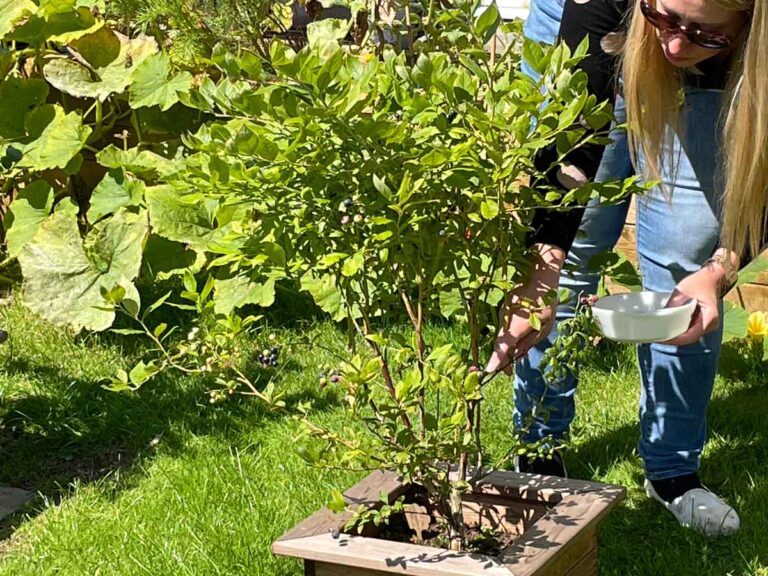
The best blueberry types for growing in pots
Before you buy any blueberry plants, you’ll need to think about where you will grow them. Blueberries come in many different varieties which fruit in different climates and at various times of the year.
There are two main types of blueberries – Northern Highbush and Southern Highbush. While the Northern Highbush is better suited for cold climates with cold winters, the Southern Highbush thrives in milder, warmer regions.
Make sure you understand which type of blueberry will thrive in your region and start from there. If you aren’t sure, have a chat with an expert at your local garden center.
When it comes to actually purchasing your blueberry plants, I would suggest buying two bushes. Most blueberry varieties are either partially or fully self-pollinating, but you’ll find they will produce much more fruit if they can cross-pollinate.
If you are looking to maximize your yield, buying at least two bushes will help achieve this – more is even better.
The best pot size for blueberry plants
Blueberry bushes have shallow roots so you are better to choose a large pot to allow lots of growing room for those roots.
Make sure you have a pot with holes in the bottom that will allow for the plant to drain when you water it or when it rains, otherwise the roots of your blueberry bush will rot.
What soil is best for potted blueberries?
Blueberries prefer acid soil, or ericaceous soil as it is also known which has a pH of between 4.5 and 5.5. (affiliate link) I’d suggest buying yourself a bag of good-quality ericaceous soil and using this as your potting mix.
If you are using other soil, you may need to treat your soil with sulphur to lower the pH to ensure that your blueberries thrive. Blueberries also prefer the loose, easy draining texture of sandy soils.
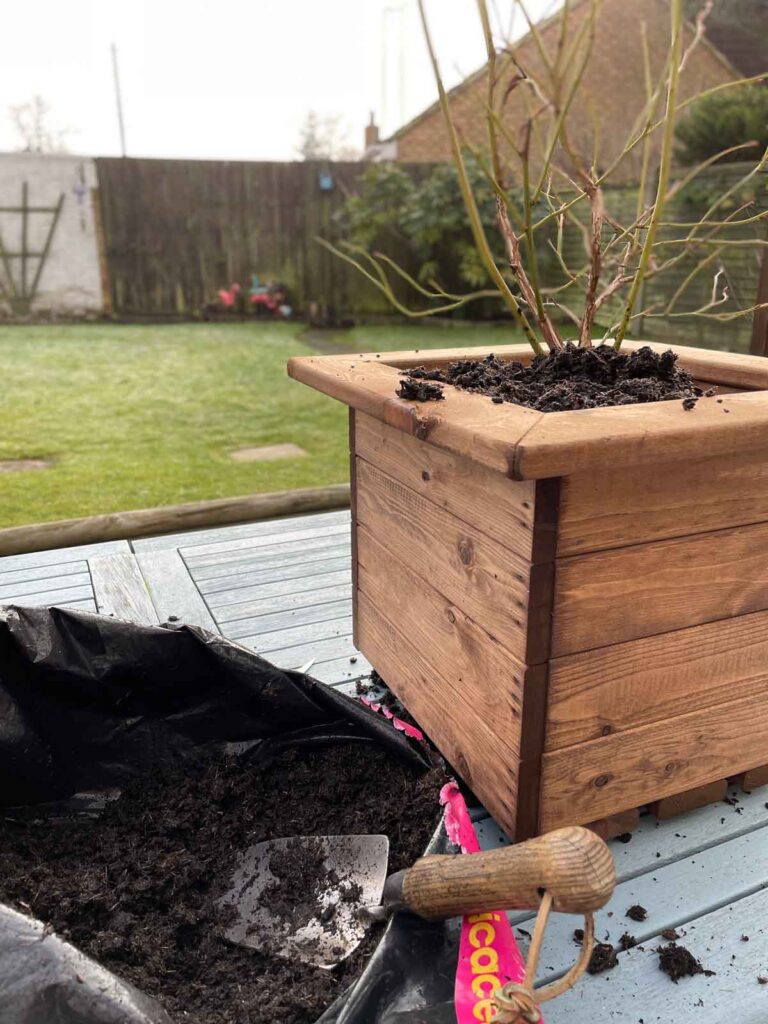
How to Grow Blueberries in Pots
Here’s a step-by-step guide to potting up your blueberries.
Start by adding a layer of ericaceous soil to your chosen pot.
With gentle care, remove your blueberry plant from the container that you purchased it in and place it into your prepared pot. You’ll want to make sure the top of the root ball is going to be level with the soil surface.
Gently fill around the plant with more soil. Tap it down gingerly to remove any air pockets.
Give your blueberry plant a good, thorough drink of water after planting. This will help it settle into its new pot. Watering should be done with rainwater rather than from a tap or hose.
How to Care for Blueberry Bushes
Growing blueberries in pots is relatively easy, but you should be aware of a few factors that will make the difference when nurturing your blueberries until they are ready to harvest.
Sunlight
Blueberry bushes thrive in full sun, so place your pots in a sunny spot where they receive at least 6-8 hours of sunlight daily. This will help your plants flourish and your fruits ripen.
Watering
Blueberries don’t like to dry out. So ensure that you water them regularly to maintain moist soil, particularly during really dry periods. If you fail to water them, you’ll find that the blueberry blossom will fall off and any fruits which do appear will be small and less tasty.
Blueberries also love rainwater, it helps them maintain the pH level of the soil. If you live in an area with chalky water and you water your blueberries with tap water from a hose regularly, you will find that this will alter the pH of the soil.
If you are unable to water using collected rainwater, you should test your soil regularly and add sulphur or top up using acidified soil.
Feeding
Blueberries are heavy feeders, and they benefit from regular fertilization. Use an organic (affiliate link) fertilizer designed for acid-loving plants, not only will this help maintain the pH levels of your soil, it will help you grow bigger, juicier blueberries.
You can apply fertilizer approximately every 3 weeks during the growing period which is usually early spring to later summer.
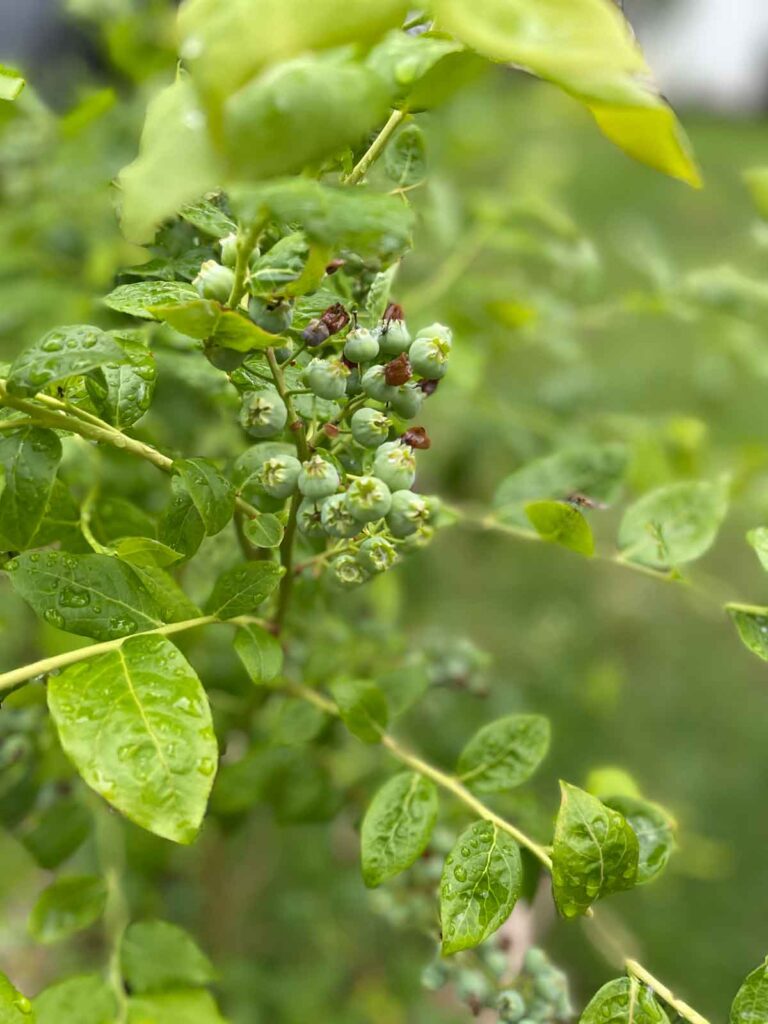
Mulching
Applying a layer of mulch, such as pine needles or compost, around the base of the plant helps to conserve moisture, regulate soil temperature, and deter weeds.
This is particularly useful in the winter months when it can be quite chilly and this will help to stop the roots from freezing and rotting.
Pruning
Depending on how mature/large your new plants are, you may find it best to remove any flowers that appear to encourage root and branch development in the first year.
If you have bought more established plants, you will enjoy fruits from the very first summer.
After they have fruited, you can prune them annually during late fall or late winter to remove any dead or weak branches.
Protection from Late Frosts
If you find that you have a warm spring followed by a late snap of cold weather, you may need to protect your early flowering buds from the frost. This can be done with some horticultural fleece. Depending on the climate you live in, this may be a factor throughout April into May.
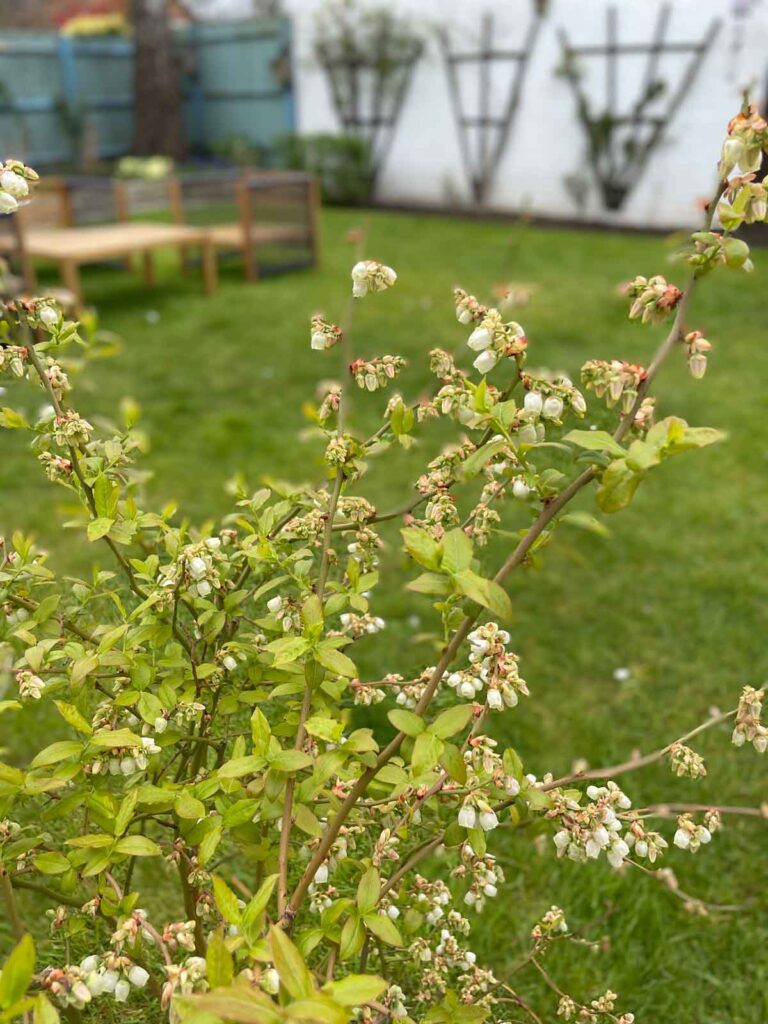
Optimal Soil Conditions
It’s really important that you maintain the right soil conditions for your blueberries to remain healthy and productive, so I’ve put together some additional tips to help you achieve the ideal soil pH and quality:
Soil pH
Regularly test the soil’s pH using an (affiliate link) soil test kit, and adjust it as needed to maintain an ideal pH level between 4.5 and 5.5. If your tap water is alkaline, consider using rainwater or an acidifier to maintain the acidity of the soil.
Chill Hours
Blueberry plants require a certain level of chill hours during the colder months. This allows them to produce higher yields when they fruit. This is also the best time to buy and plant your blueberry plants.
Blueberry plants need exposure to temperatures between 35°F and 45°F during the winter months, during their dormant period. This does depend on the variety, so do your research at the garden centre or online with the grower before you buy. Temperatures colder than this range will not count.
Southern highbush varieties require fewer chill hours than other varieties, so when you are looking around for the varieties that will suit your region and climate, make sure you choose the ones that are mist suited to the conditions in your garden or allotment.
If a blueberry plant doesn’t get enough chill hours, then it will likely suffer with lower yields
Drainage
You must ensure your pots have good drainage, as blueberries don’t like waterlogged soil. Sandy, well-drained soil is particularly well-suited to blueberry cultivation. You can add crocks or rocks to the bottoms of the pots to help with drainage if you find this is an issue.
Location
The location of your potted blueberries can help or hinder the success of your harvest. Consider the following factors to maximise your yield from your bushes.
Blueberries need full sun to thrive. Ensure your pots are placed in a sunny spot where they can bask in the sunshine in abundance.
Be prepared to cover your pots if late frosts occur to protect the early delicate flowers and buds from damage from the cold weather.
Give your blueberries enough room to grow by spacing the pots at least 3 feet apart in all directions. As I mentioned before, having more than one blueberry bush will help produce more fruit, but make sure they are adequate spaced to give them room to grow and flourish.
Harvesting
The best part of growing blueberries is harvesting (and eating of your precious fruits). When you harvest will depend on the varieties you grow, but blueberry plants generally produce fruit in late summer, normally around July or August.
You’ll know exactly when they are ready when the green or light purple berries will turn a deep rich blue color. You’ll need to be quick to beat the birds as the color of the berries is like a magnet to them.
Harvest your blueberries regularly and this will encourage more fruit to grow. This will ensure you have an abundance of blueberries throughout the summer.
The actual yield from your container-grown blueberries will depend on all of the above factors that we have discussed – the variety, climate, and care. However, you can expect high yields if you provide the right growing conditions and look after your plants well.
Key points about growing blueberries in pots
- Growing blueberries in pots is an excellent choice for those with limited space. It’s a great way to grow fruit on a patio or right outside your back door.
- Blueberries prefer an acidic soil which is easier to control in a potted environment.
- By selecting the right blueberry varieties, preparing the ideal pot and compost, and providing the right care, you can enjoy your blueberries throughout the summer from your own garden.
Whether you’re a novice grower or an experienced gardener, the joy of growing and harvesting your own blueberries is a worthwhile pursuit. Remember that every variety of blueberry bush has its own unique personality and requirements so ask some questions up front at your garden centre before buying. Why not pick a couple of types and see which one rewards you with the most fruit? With a little care and attention, you’ll be enjoying the sweet rewards of homegrown blueberries this summer. Happy blueberry harvesting!
Grow even more with these easy seed starting milk jugs!
About the author
Meet Sally Allsop
Sally Allsop is an avid gardener and founder of the online gardening site All That Grows–an inspirational gardening blog, covering growing fruit, vegetables and flowers. Get your hands dirty with useful hints and tips to help you get the most out of your garden, plus other DIY garden projects.

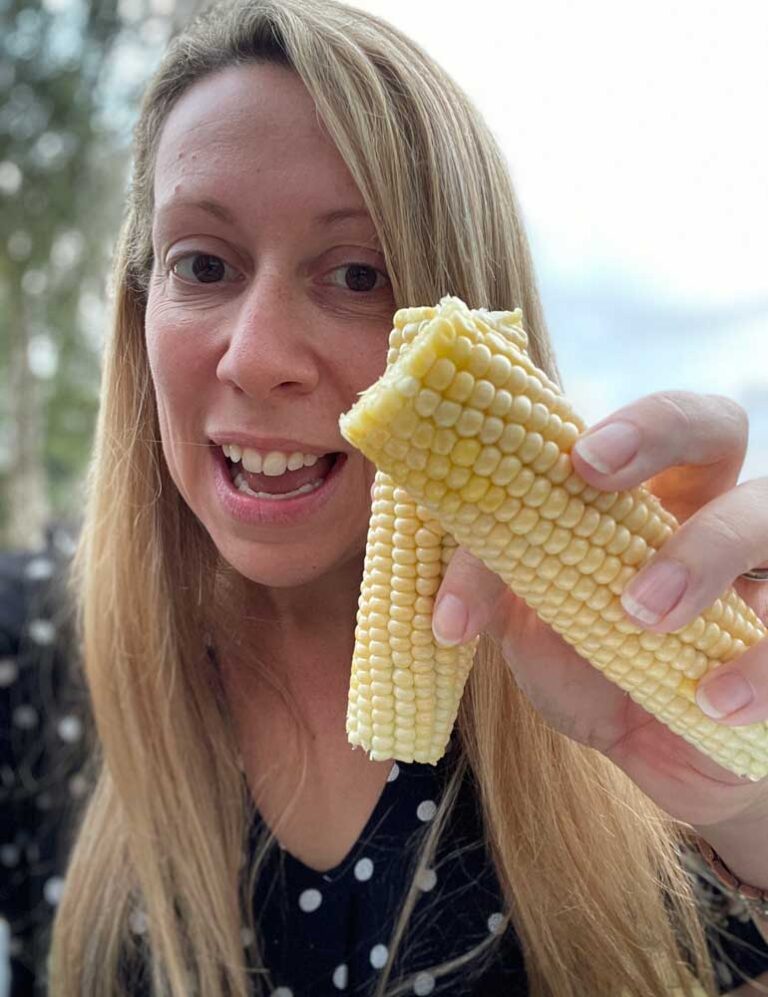
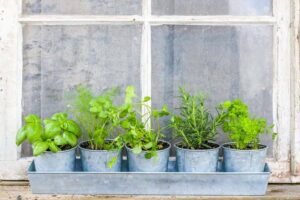
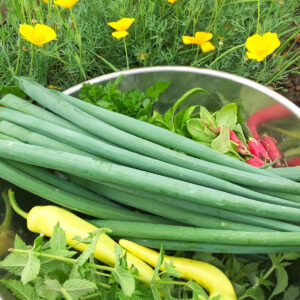
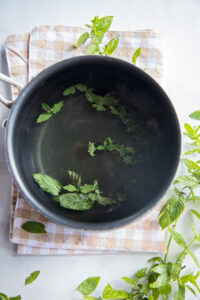



About the Author
Rachel Ballard, RN, BSN brings more than 20 years of professional nursing expertise to Feast and Farm. With a love for nutrient dense foods that support wellness, she works to distill complex health information and current trends into recipes that fuel the best version of yourself. Read more about Rachel here.